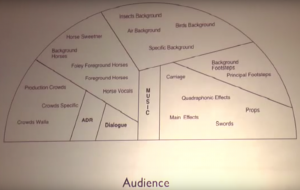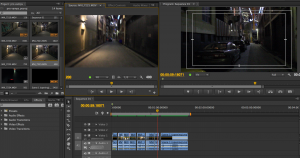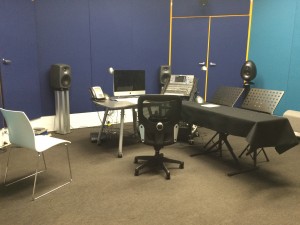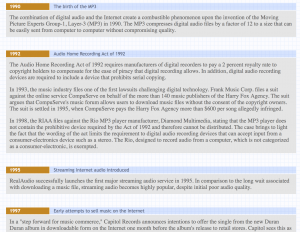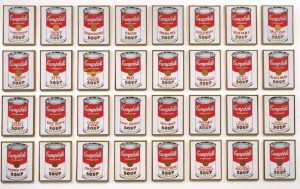Sound
What Juvies sounds like
The sound design of our film would be the experimental aspects for me into trying out different methods whilst producing the piece. What I’m aiming to play out for the audience is for them to hear a correlation of sounds to the character’s mental subjectivity. Whether it is the sound of running water to portray calmness and security, or upbeat intense bass sounds to portray discomfort or emotional instability. To put on unique kind of sounds orchestrated as a unity would be something I am excited to experiment on. Walter Murch mentioned..
Similarly, I would put the dialogue or voice overs as the more dominating sound for the film. But rather for music, I thought of putting it as a subtle supporter of the character’s situations, which takes its place more towards the back or the sides of the orchestra. Instead, environmental sounds are equally important to portray the character’s mental subjectivity and emotions in which then would be placed among the sides of the orchestra.
These sort of sounds curated are of environmental sounds that naturalistic and may take part in our film. We need these sounds to enhance the sense of realism and a more pronounced way of how individuals hear their surroundings. Characters are therefore correlated with environmental sounds as if that is what they are listening to or hearing what they take in from their environment. Again, that will contribute into conveying their mental subjectivity.
- Water running; taps, fountains, waves
- Wind
- Trams
- People chattering
- Sounds of doors
- Breathing
- Footsteps
Music and rhythmic melodies that I have found from free music archive websites are crucial into creating that aura of dramatic tones. These background musics allow us to generate a more impactful effects towards the audience. It serves as a bridge in connecting the character’s emotions and engagement with the audience.
Upbeat and jumpy tones (White Limit):
- Excitement
- Ryan meeting/engaging with Julie
- Playful
- Interests of Ryan’s emotions
Jumpy tone (White Limit) with mellow tensity:
- Discomfort
- Emotional instability
- Journey/ experiences
- Flashbacks
Rock electric guitar (Let’s Make Hate):
- Adventurous side- Characters sharing stories
- Hardship of past experiences
- Crimes
Celeste clinking bowls (taken from NGV):
- Water creates calmness
- Randomness, the unpredictable pattern- symbolises character’s psychological and mental disorders
“Let’s Make Hate” music symbolises adventurous side of the two characters into sharing their stories and form their relationship. Also, the electric guitar rock kind of sound relates to the hardship of experienced they had all the crimes they did and their time in juvenile detention centre to modify themselves. The chill, slower but mellow tone of this music symbolises their never ending journey that they keep going on and that life goes on. Furthermore, during their slow pace along walking on their journey it shows that they don’t have to rush, and that in learning about their identity they need to take their time. The mental disorders and “messiness” is symbolised by the clicking bowls on the water sounds that are random and not in order, which also portrays that we cannot always predict the human mind.
Voice overs and dialogue corresponding to the background music in our film is inspired by one scene from Gia Coppola’s Palo Alto (2013).
What’s Sound Design?
- Aid to filmmaker
- Aid to audience
- Manipulation of the audience
- Creation of a subjective environment
- Creation of a sympathetic environment
Here are some quotes from the Walter Murch playbook:
“It (sound) should strive to create a purposeful and fruitful tension between what is on the screen and what is kindled in the mind of the audience. The danger of present- day cinema is that it can suffocate its subjects by its very ability to represent them: it doesn’t possess the built-in escape valves of ambiguity that painting, music, literature, radio drama and black-and-white silent film automatically have simply by virtue of their sensory incompleteness — an incompleteness that engages the imagination of the viewer as compensation for what is only evoked by the artist.” -Walter Murch
“By comparison, film seems to be “all there” (it isn’t, but it seems to be), and thus the responsibility of filmmakers is to find ways within that completeness to refrain from achieving it. To that end, the metaphoric use of sound is one of the most fruitful, flexible and inexpensive means: by choosing carefully what to eliminate, and then adding back sounds that seem at first hearing to be somewhat at odds with the accompanying image, the filmmaker can open up a perceptual vacuum into which the mind of the audience must inevitably rush.” -Walter Murch
“On The Eye” progress
Brief 4 Final
Final sequences:
Finally, it is week 12 and every single assignment that has been haunting us is all finished. My Popular Cinema essay, Creative Advertising “post-card” campaign and now the On The Frame brief 4 exegesis and the test sequences are all over. The last blog update was about the process of this brief 4 project up to the point where Dyy and I just finished shooting. So here are some progress made since then on.
The editing process, which took a while longer as a result of technical (Premiere Pro) incompetence. At first we thought that we could include some background music and sound effects, though we changed our mind to stick with the natural background sounds recorded diegetically. This is because I think it works better in focusing dominantly on the frame’s aesthetics and movement rather than some music added in. While I was editing the opening scene, I found that it was quite hard to have the sequences matching up with the storyboard that I have sketched. Therefore while trying to follow my storyboard, I have also done some experiment on cuts and matching shots and have learned a whole lot more in how to overcome problems in Premiere Pro (mainly through You-Tube and Linda.com). There were shots that needed to be cut and put together. Though as the shot images “rule of thirds” do not match that it obviously show an unwanted cut between those shots, I have learned to use fast-forwarding the duration of the two shots while adding an “additive cross dissolve” video transition effects to make the two shots seems as one.
Focusing greatly on both the opening scene and the ending scene, we decided to only edit and submit these sequences as tests or experiments without having the whole film drawn in the storyboard fully finished. Throughout my exegesis, I am also able to answer the research question that if “the camera is an extension of human body, can then film think and develop just as human being do?” This is an interesting notion that film is able to, as it is a mirror to human mind therefore can think. Futhermore, film can stretch its ideas as a result of the possibility that it is a form of future thinking, hence develop its thoughts just as human being learns new knowledge.
The Dosier
Brief 4 Interview…
As a part of our audio documentary, we have thought to include experts interviews to give a more variety and tone of voices. Bianca went off and interview Nic McKenzie and Louis Rocketeer/ B.Deep, the two music recorder artists. Patrick in the other hand, had set up a meeting for an interview with Dr. Lawrence Harvey at the SIAL studio (Spatial Information Architecture Laboratory) in the Design Hub. So both Patrick and I met up with Lawrence, walking through overwhelming “couple” of hallways and down the stairs until we reached the studio.
So many crucial information have been obtained by Patrick as the interviewer and me holding the mic. We have gotten to know Dr. Lawrence more as well as he introduced us to the inside of SIAL Pod, sound systems and its gear. Especially when he played us an audio of Spatial Sound travelling through 14 speakers surrounding the three of us in the centre of the room. Awesome!
Brief 4 in progress…
Looking through various and heaps of articles for our research, I have found several interesting timeline for audio technologies and informations throughout the evolution.
From these researches, Bianca, Patrick and I put the whole information into the script for the audio recording.
Adding to our minutes, we’ve met in week 11 to finish off our script and went into the studio. Patrick had taken care of borrowing the recorder and the mics and setting them all up and ready for recording. Bianca, having the nicest voice gave her narration in a great and successful speech. It was quite a long day after having a second take for Bianca’s narration and Patrick downloading all the voice notes and ready for editing. But I’m happy and relieved that we have made progress in this project with both Patrick and Bianca being helpful teammates. This is a photo of the sound-proof studio we went to do our recordings:
Remixes & Reproductions
Dan explains today that “There’s no such thing as an original idea”. Week 11 lectorial proposes an interesting topic on reproductions and how DJs come about from the histories of discotheque and night clubs. During the 1920s the people would dance to music on a piano or Jukebox. Where in the late 1970s, DJs would have been needed to provide music with seamless transition between songs. Even then, the birth of the Internet has allowed these artists to perform their art, downloading song whether or not there is still a matter based on copyright infringement. The question is how authentic is the reproduction and how much of the aura is captured? Because we can never capture a moment exactly as it is in reality which is different from the digital world. We can try but always have been fragments in our memory.
“This Is The Remix”
Girl Talk
Andy Warhol’s Campbell’s Soup Cans
“Pop art does not describe a style; it is much rather a collective term for artistic phenomena in which the sense of being in a particular era found its concrete expressions…”
(Osterwold, pop art, p.6)
Listen to me!
In reading media texts, we need to listen to the sounds being produced. I found this video from You Tube by thebigtinonetwork about a little boy learning and behaving as his parents from observation and listening. Like what the kid is saying… Listen!
Sound is…
- Pervasive
- Multi-directional
- Complexly layered
- Prioritised by the ear
- Intimate
As aural semiotics, it place the listener in a mediated or imagined perspective. These perspectives include figure, ground and the field. There is a difference between perspective and the system of social distance. Where social distance applies to single sounds, perspective applies to the simultaneous sounds and has relatives rather than absolute levels. Moreover, social distance creates relations of different degrees of formality between the representation and the listener.
Figure: The focus of interest
Ground: The setting or context
Field: The background or ambient space, what is heard
Soundscape
Soundscape refers to representations of a place or an environment that can be heard, rather than be seen. It is understood by individuals in different ways. Some of us can listen to music and actually understand its sounds and notes. But some does not. Some are more sensitive with particular sounds like the air whooshing when others just listen to its silence. Silence itself doesn’t exist and when I think about it, I hear every time even of the fridge whirring when nothing else seems to sound.
Man Of No Ego – Slowing Down (Web of Life)
How sound is complemented
Reading Log #7
Sound in the cinema is a crucial component to cinematic narration processes. They give cues in both onscreen and off-screen as audiences synchronize what is shown to the sound produced. Cues given by sounds allow audiences to anticipate and understand the intended reading of the narrative, besides according to their experiences.
As exemplified in Vivre Sa Vie, 1962 by Jean-Luc Godard, the voices of the characters are often off-screen while the character itself is not present on the screen. This use of dialogue gives cues in which the audience understands that the character on screen, who is not speaking nor moving any lips movements, is communicating with the character that is off-screen because of the use of the character’s voices.
The presence of background noises like those in the café scene is the diegetic effect as we hear the plates and cups clanking. But as there is a dialogue between the characters, this low-pitch and average-volume dialogue sound is dominant and guided our attention (or to listen) to itself whilst the low-volume noises are secondary mixing of sounds. This is followed by a background music coming in. This French musical soundtrack is the non-diegetic effect that adds timbre and harmony to the scene. As the character speaks, there are moments of silence and this is a motif shown throughout the film. The purpose of this silence is to guide the audience focus and attention on the scene/shot presented.

